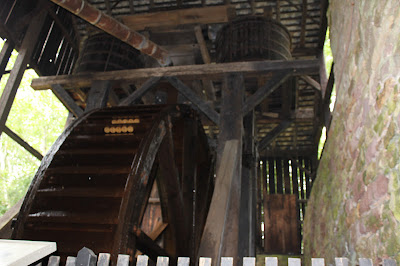Every once in awhile, Keith states that he needs a change of scenery. This past weekend was one of those times. Without a lot of planning, we headed out Sunday morning to Hopewell Furnace, a National Historic Site about 45 minutes away. Neither of us had ever been there before (and of course, Bert hadn't either) and it is always fun for us to go places that are new to all of us. Oh, and it never hurts if those places are free.
We arrived around 11:00 or so, having stopped for breakfast on the way. At the visitors' center, they were just starting a 15-minute film about the site so we slipped in quickly. The park ranger pointed out a basket of stuffed animals that we could grab to entertain Bert but he still only lasted about 5 minutes in the little theater so Keith took him out and looked at some of the displays while I watched the rest of the film. To sum it up, Hopewell Furnace produced iron goods, from cookstoves and household goods to cannons used in both the Revolutionary and Civil Wars. It operated until 1883, when it could no longer keep up with more modern steel production. The site was more or less abandoned for the next fifty years, until it was restored as a Civilian Conservation Corps project. Pretty much all the buildings are open to the public and there are demonstrations on weekends as well.
 |
| I think this was the cooling shed, where charcoal was brought from the woods to the furnace. |
 |
| The ironmaster's mansion |
The ironmasters' mansion has 19 rooms, several of which you can view on the first floor.
I didn't notice anything about guided tours but visitors are free to walk all over the grounds.
 |
| The company store |
The barnyard was fascinating to Bert.
Behind the house there was a spring house with water running through it. The sign said it was where they did laundry and butchering.
 |
| Looking down into the spring house |
There was also a blacksmith's shop, with a gentleman doing demonstrations and explaining the differences between different kinds of iron (cast, wrought, steel, etc.). It was full of all kinds of tools.
 |
| A pretty little stream running through the site. |
At 12:30, there was a demonstration in the furnace house showing how the workers made sand molds and explaining how the furnace operated. They told us that the furnace took three weeks to reach temperatures hot enough to make iron and when it was ready to be poured, a bell would ring and the molders would rush to the building to fill their molds.
 |
| This is where the term "pound sand" comes from. Really, I'm being serious. |
 |
| A mold for the door of a woodstove. Hopewell Furnace had 23 models and sizes of wood and cookstoves at its peak. An experienced worker could mold 3 stoves in 2 days while the furnace was running. |
 |
| The opening to the furnace where the iron poured out. |
 |
| Ladles for dipping the hot iron as it came out of the furnace. |
 |
| Iron that couldn't be put in molds fast enough was run out into troughs as pig iron. |
Bert was pretty impressed too.
 |
| Bert plays with a cannon. |
 |
| You can walk all through the coal furnace ruins. |
The people who tended the charcoal pits in the woods (I think they were called colliers) lived in primitive huts that looked something like this. A collier could tend several pits at once and sometimes as many as three would live together in a hut so they could tend up to nine pits at a time.
There were some other really interesting things we learned, like for most jobs, men and women worked side by side, as did blacks and whites. Hopewell Furnace had "equal pay for equal work," so they were pretty progressive for their time in terms of equality. Interestingly enough, when it became a CCC project, blacks and whites worked separately.
I think on Saturdays they do a demonstration where they heat up a smaller furnace and melt aluminum and cast it in the molds, which would be neat to see. It's worth checking out their website and reading up on what events are going on, like apple picking in the fall, and other trails you can walk. We had a nice time and were happy to wander around on our own (rather than worry about Bert getting antsy on a tour) and think this would be a great place to go back to when he is old enough to be learning some of these things in school. We spent almost three hours there, which seemed like plenty of time to do what we wanted but you could make a longer day of it with the trails and other demonstrations.



























No comments:
Post a Comment